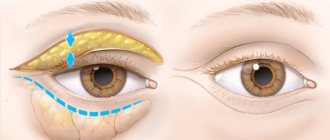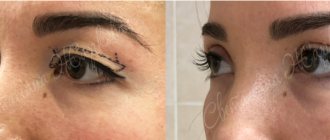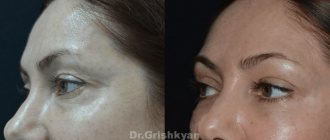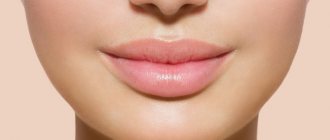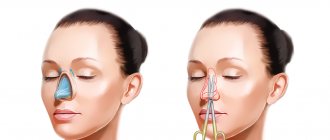Swelling after correction of the lower and upper eyelids is a normal reaction of the body to surgery. Small capillaries and vessels are touched by the instrument during the session, which leads to stagnation. Swelling reaches its limit after three days, then a decline follows. If large vessels are injured, bruises occur (red blood cells collect in the tissues with lymph, coloring the outer layer of the dermis in a purplish-bluish tone). Swelling is often accompanied by a feeling of sand and pain in the eye area, which is also considered normal.
What happens and how does swelling form?
Surgical lifts entail the destruction of soft tissue and the integrity of the skin. Such consequences are typical even after endoscopic surgery - just a few millimeter punctures are enough for a reaction to begin:
- increased permeability of arterial vessels - water comes out through the bloodstream, accumulating in the interstitial space;
- compression of the lumen of blood vessels and venous tissue - which prevents the outflow of blood and lymph;
- swelling - the more pronounced the initial period, the sooner the eyelid becomes swollen, and a longer period of resorption is required.
Excess water can also transfer to nearby areas, for example, to the cheekbone area.
On the lower eyelids
An edematous reaction is inevitable, only the degree of severity changes. The most intense swelling (up to the zygomatic area) occurs after classical surgery. Congestion is not as pronounced if it is transconjunctival blepharoplasty - fewer vessels are affected. The lower eyelid usually recovers within one week, although the patient's personal tolerance also matters.
On the upper eyelids
The dermis of this century is thin and more vulnerable. Swelling after blepharoplasty is usually almost unnoticeable, but it takes longer to go away because the area is less supplied with blood. To neutralize the side effect, use cold compresses.
Let us separately consider the situation when there is asymmetry of the eyes. This is possible in several cases.
- The patient was in a condition not directly related to fluid accumulation. This includes deterioration of muscle tone, unsynchronous healing, or other complications leading to asymmetry. Additional measures may be required, including repeat surgery.
- The degree of intervention was different for each eye. Where the hernia is more pronounced, it was necessary to remove additional excess skin. Accordingly, the swelling after blepharoplasty in the photo has become more noticeable.
Can complications arise?
Every operation is fraught with unpleasant surprises, even in the absence of all contraindications and the presence of good tests. No surgeon can foresee how the patient’s body will behave during an intervention. Let's look at the most common unpleasant consequences:
- double vision . This defect is temporary. It is caused by a disorder in the coordinated functioning of the oculomotor muscles. This complication does not require special treatment; most often, the doctor can recommend eye exercises, which will help restore the function of the visual analyzer. On average, this condition can last up to three weeks;
- increased lacrimation . Watery eyes after blepharoplasty are caused by swelling of the soft tissues, which causes displacement of the tear ducts. There is no need for treatment. As swelling decreases, lacrimation will disappear;
- retrobulbar hematoma . A fairly rare complication caused by hemorrhage behind the eyeball. Symptoms of this condition are: protrusion of the eyeball, pain in the eyes, limitation of movements. If you find yourself with at least one of the signs, you should immediately seek advice from an ophthalmologist, as this condition is considered dangerous;
- inversion of the lower eyelid . It occurs infrequently and occurs due to non-compliance with the instructions of the attending physician, or an error by the surgeon who removed too much subcutaneous tissue or skin during surgery. Due to the formation of deformation of the eyelids, the patient is unable to completely close the palpebral fissure. This occurs due to the formation of an open area of sclera between the lower eyelid and the iris. One of the accompanying symptoms of eversion is dry mucosa. Special eye exercises and massage are effective for this complication. Such actions can correct the situation only with minor deformation; if the pathology is more severe, only repeated surgical intervention will help;
- dry conjunctivitis . This condition is not considered to be a direct consequence of the operation. Most often it occurs due to infection in a postoperative wound during the rehabilitation period. To moisturize the mucous membrane and reduce discomfort in the eye area, special eye drops are used that will help eliminate complications after surgery.
When will swelling go down after blepharoplasty?
The swelling lasts for 1-2 weeks, but sometimes the rehabilitation period lasts up to a month. The duration of recovery is determined by the following factors:
- the age of the patient - over the years, tissues regenerate more and more slowly, so swelling takes longer to subside after 45; at this age, circular blepharoplasty is usually performed, which is more traumatic;
- type of operation - with extensive surgery (correction of Asian eyes, etc.), swelling of the eyelids after blepharoplasty is more pronounced, there are bruises; full recovery requires two weeks; the seamless option is less traumatic - in this case the tissues regenerate much faster;
- individual characteristics - vessels located close to the surface of the dermis lead to stagnation (bruises lighten more slowly); If the skin is thick, the swelling also lasts longer than usual.
Normally, the tumor can grow and shrink. In a vertical position, gravity pulls the liquid downward. As a result, swelling after lower eyelid blepharoplasty becomes more noticeable in the morning. During the day, the patient stands or sits more, therefore, under the influence of gravity, swelling, on the contrary, decreases. The lower eyelids swell more noticeably than the upper eyelids, even if only upper blepharoplasty was performed.
In the table we will look at how long swelling lasts after blepharoplasty and the level of swelling by day.
| Number of days | How to improve your appearance |
| 2 | After the session, the eyelids are only superficially swollen. The applied sutures are covered with antiseptic patches. The eyes swell after eyelid surgery gradually, reaching a peak by the end of the second day. Hematomas often spread to the cheekbones. |
| 4 | The water that used to come in goes away over time. The tone of the bruise changes - it becomes pale and smaller. |
| 7 | The swelling noticeably subsides. However, it is too early to talk about impeccable appearance. |
| 10 | Only small swellings and incompletely resolved hematomas reveal the recent session. |
| 20 | The face looks normal, although there may still be some water left. Slight asymmetry is possible. |
| 20-60 | Full recovery. All residual factors and symptoms disappear completely. |
It is worth focusing on the schedule when the person operated on has no contraindications, as well as other negative factors. These include:
- diseases that increase swelling (malfunctions of the urinary/cardiovascular systems, etc.);
- not fully following the doctor's recommendations.
Additional factors:
- technology and volume of surgical work;
- skin characteristics - the greater the permeability, the more visible the excess fluid;
- layer of fatty tissue - with a greater thickness, water is retained for a long time, contributing to the slow resorption of edema.
Indications for lower blepharoplasty
Surgery can significantly change the appearance and rejuvenate the face. Indications:
- hernial formations filled with fatty contents, which form bags under the eyes;
- wrinkles and sagging of the lower eyelid due to excess skin and loss of elasticity;
- the appearance of a tear trough due to the retraction of the lower eyelid, which is typical for older people;
- ptosis of the tissues of the lower eyelid;
- defects of the lower eyelid resulting from injuries or previous diseases.
Blepharoplasty results
The effects of lower eyelid blepharoplasty are achieved using various surgical techniques, but all of them can eliminate the problem with which the patient consulted a doctor. After a lower eyelid lift, patients achieve the following results:
- bags under the eyes disappear as all excess skin is removed;
- wrinkles are removed, the periorbital area is smoothed;
- externally, the aesthetics of the face significantly improves, it looks fresher.
When planning to undergo canthopexy of the lower eyelid, patients expect exactly these effects. To avoid being disappointed with the results, choose trusted clinics. “Miracle Doctor” in Moscow is guaranteed to perform the procedure at the highest level and solve all the patient’s cosmetic problems. The price is available in the price list on the clinic’s website.
Contraindications
Contraindications relate both to local restrictions and to the general condition of the body, in which surgical intervention is not recommended at the moment or at all. Limitations of lower eyelid plastic surgery include:
- sudden jumps in blood pressure;
- diabetes mellitus, in which tissue healing is difficult;
- oncological diseases;
- pregnancy and lactation, menstruation;
- low blood clotting, hemophilia;
- liver and kidney diseases;
- inflammation of the tear ducts;
- retinal detachment;
- conjunctivitis;
- infectious diseases.
Preparation
Blepharoplasty is a full-fledged surgical intervention in which the patient is required to undergo a series of examinations. Before the operation, the doctor will prescribe a series of tests for the patient, the results of which will reveal contraindications:
- electrocardiogram;
- fluorography;
- blood test - general, for human immunodeficiency virus, hepatitis and syphilis, coagulability and Rh factor;
- Analysis of urine;
- ophthalmological examination - analysis of visual acuity, eyelid tone.
If necessary, additional research may be ordered. Taking into account the results, the most appropriate method of intervention is selected to achieve the desired effect. Before the operation, the patient must abstain from alcohol two weeks before the procedure, take certain medications (primarily blood thinners), eliminate allergens from the diet, and the day before the operation, avoid hard-to-digest foods.
Doctor's advice
From the table you will find out how long swelling lasts after blepharoplasty, as well as what advice the doctor gives. Daily instructions on how to relieve swelling after eyelid surgery are gradually becoming less stringent.
| Number of days | Doctor's recommendations |
| 1 | In hospitals, procedures must be performed by a nurse. At home, it is necessary to reduce activity as much as possible, apply cold and treat the skin with special preparations. |
| 3 | It is allowed to take a shower and wash your hair without getting shampoo and water in your eyes. Frequent blinking should be avoided. |
| 6 | Medical stickers or stitches are removed. The swelling (normally) begins to subside. At this stage, not following the doctor’s recommendations can significantly aggravate the situation. |
| 10 | It is allowed to resume using contact lenses and start working on a PC, but without overworking. |
| 14 | You can apply eye shadow and mascara, but only those intended for sensitive skin. |
| 15-60 | You are allowed to sleep in any position and gradually increase physical activity. The surgeon prescribes physiotherapy sessions and medications. |
How to reduce swelling yourself
To relieve eye swelling after blepharoplasty or to make it less pronounced, an effective method of preparing for the session has been developed. To begin with, 7 days before surgery, you need to quit smoking and drinking alcohol. You should stop taking blood thinners (anticoagulants) in advance. Reduce salt intake: it helps retain moisture in tissues. Also, contact only qualified surgeons who are proficient in the latest methods of atraumatic correction with minimal likelihood of complications.
Cold in the form of ice is the most powerful anti-inflammatory agent. Doctors recommend treating the wound with cold almost immediately after the end of anesthesia. In this case, you should not bow your head or suddenly change the temperature of the affected area. During the first 48 hours, ice packs help reduce pain after upper eyelid blepharoplasty and the swelling itself. Ice is applied to the cheeks and eyelids, at intervals of 30 minutes while awake, and kept for 20 minutes - the skin should become cool to the touch. Cold is not applied at night.
Here are some rules to help reduce swelling:
- do not drink alcohol, do not smoke - especially carbonated alcoholic drinks are prohibited;
- avoid any physical stress, rest more, relax - at first you should not lift weights exceeding 4 kg;
- at night, lie on your back, with a high pillow under your head, preferably half-sitting;
- during the two-week postoperative period, wash your hair, as in hairdressers, throwing it back;
- eliminate activities that cause frequent blinking - working at a PC, watching TV, reading in a dimly lit room;
- maintain water balance, without significant deviations from the norm;
- At first, avoid being in the sun;
- give preference to healthy light foods;
- Swelling is also affected by air pressure and hormones.
Sometimes a sunken eye effect may occur; structured fat grafting is used to correct it.
What else can help?
From the fourth day, an antiseptic cream is usually prescribed. Experts advise using the drug "Traumel", which effectively fights against severe swelling after blepharoplasty. When the wounds have healed, a finger massage is performed with gentle tapping. At the same time, such drugs as “Contractubex” and “Hydrocortisone” are recommended, eliminating postoperative scars and scars. A faithful assistant is microcurrent therapy. It will stimulate lymphatic drainage, reduce localized inflammation, and improve bioenergetics/cellular metabolism. Swelling is also reduced by mesotherapy and lymphatic drainage massage.
Attention! Each treatment option should be discussed in consultation with your doctor. Indeed, in certain cases the use of the drug is necessary, but in others it is undesirable. To avoid complications, it is better not to self-medicate. If bruising/swelling persists after blepharoplasty for 10 days, immediately visit a plastic specialist. He will tell you what to do with eyelid swelling after blepharoplasty if it does not go away. Dysfunction of the lymphatic system is possible, requiring therapy against possible complications.
The doctor will explain what to do with swelling after blepharoplasty and will prescribe herbal remedies (Arnica, Bromelain, etc.). They are taken both after and before surgery, primarily to reduce postoperative bruises. In some studies, the effectiveness of such drugs is fully confirmed, in others, no noticeable improvements are noted. The anti-inflammatory substance here is helenalin and pineapple juice. Spinach, cabbage and other foods containing vitamin K increase blood viscosity and reduce blood leakage. Vitamins A, C, zinc, beta-carotene and copper also contribute to regeneration.
Transconjunctival blepharoplasty is a fairly simple operation. However, at first the picture is the opposite of the goal. At this stage, behind the bandages and bruises, the expected result is not yet visible. But you now know how to remove (reduce) swelling after blepharoplasty, speed up healing and thereby help your own appearance return to normal.
Ointments and creams
External remedies will help get rid of unpleasant symptoms after surgery. Effective drugs for eliminating hematomas are:
- Indovazin;
- Traumeel S;
- Lyoton;
- Hydrocortisone;
- Lokoid
To eliminate itching and speed up healing, you can use Inferase or Blepharogel cream. To ensure that the scar after surgery is smooth and soft, and the fibrous tissue does not grow, you can use the following means:
- Contractubex;
- Kelofribase;
- Dermatix;
- Clearvin


